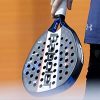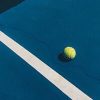The history of the game of padel comes from a similar game that began to be played in the 1920s, but the version played today was created in 1969 by Enrique Corcuera in Acapulco, Mexico and the sport is still the biggest in South America today. Padel arrived in Spain in the mid-1970s and spread to the rest of Europe.
In 1991 the International Padel Federation was founded as a global organization to promote the sport, and since 1992 world padel championships have been held.
In recent years, the sport has become widespread throughout Europe, including Sweden, where the number of members and players is increasing year by year. More courts are also being built all the time and where they will end up no one knows today.
Table of contents
What is padel?
Padel, or padel tennis as it is also known, is a game with rackets that is similar to both squash and tennis and is easy to learn. The court consists of two halves, just like tennis, is 10×20 meters, rectangular and the halves are separated by a net.
The walls around the court are made of plexiglass and it is inside these walls that the ball will be hit. Padel is always played in pairs and all players must have the correct padel racket in order to play.
History of padel
The history of the game of padel comes from a similar game that began to be played in the 1920s, but the version played today was created in 1969 by Enrique Corcuera in Acapulco, Mexico and the sport is still the biggest in South America today.
Padel arrived in Spain in the mid-1970s and spread to the rest of Europe. In 1991 the International Padel Federation was founded as a global organization to promote the sport, and since 1992 world padel championships have been held.
In recent years, the sport has become widespread throughout Europe, including Sweden, where the number of members and players is increasing year by year. More courts are also being built all the time and where they will end up no one knows today.
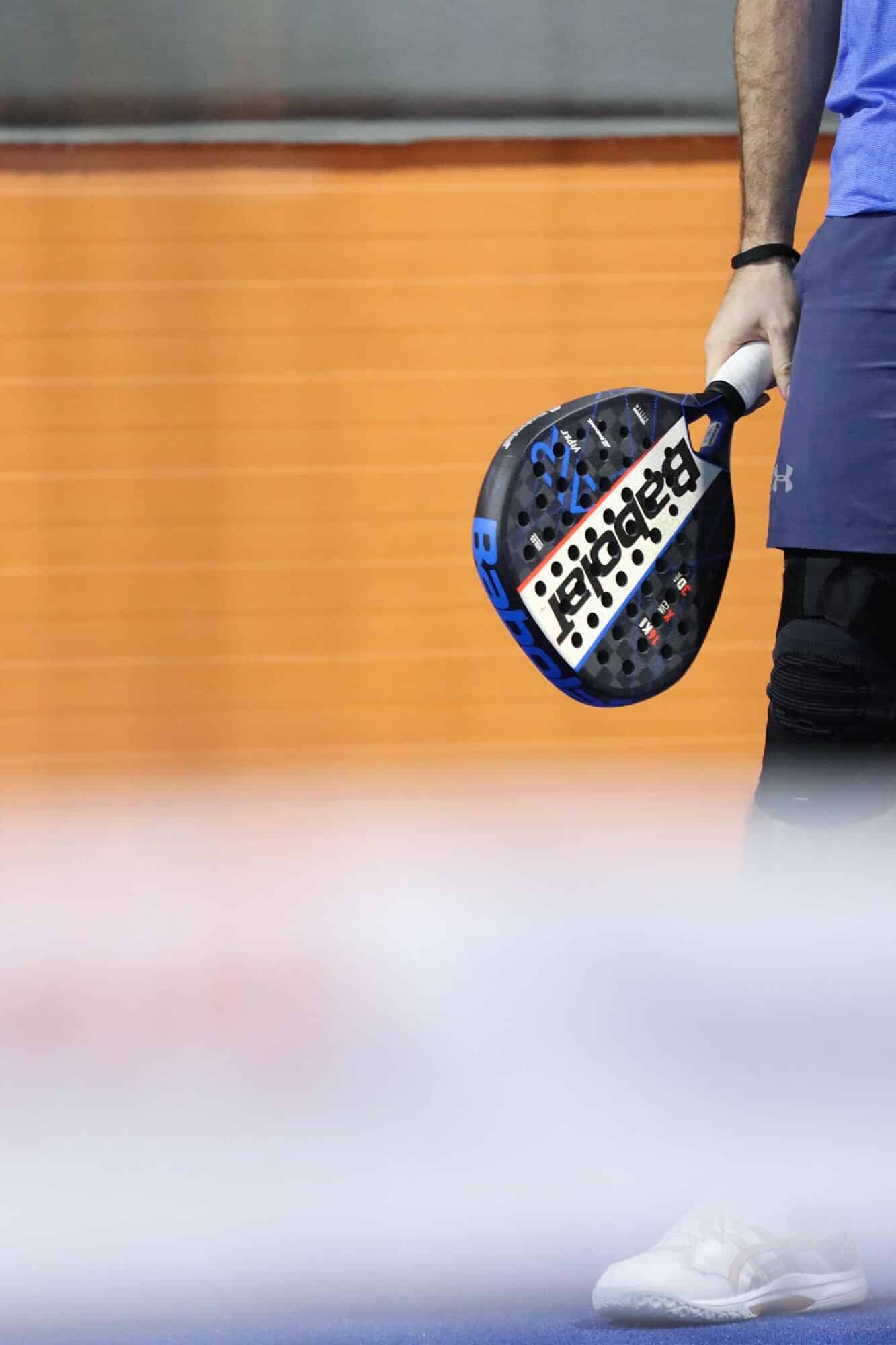
Padel racket
It is not easy to choose a padel racket that feels perfect right away. They come in a variety of designs, sizes, and weights. A padel racket is not made of strings like a tennis racket, instead, they are made of a composite material with holes in the hitting surface. This means that the ball hits the racket more softly and does not have the same force as a tennis racket.
A padel racket is divided into three shapes: diamond-shaped, teardrop-shaped, and round-shaped. A racket weighs about 350 grams, sometimes a little less and sometimes a little more. The lighter racket is usually best suited for those just starting to play padel, and also for those who are regular, intermediate-level players, but a heavier racket may be appropriate as arm strength increases. Juniors and women tend to prefer lighter rackets.
The size of the rackets is usually 36-38 millimeters, the thickest being the most common as it is a little more stable and provides more power in the stroke. A thin racket, on the other hand, is easier to swing.
Sizes of padelracket
The size of the rackets is usually 36-38 millimeters, the thickest being the most common as it is a little more stable and provides more power in the stroke. A thin racket, on the other hand, is easier to swing.
The surfaces of the padel racket
A padel racket usually has either a soft or hard surface, with the hard one giving less speed and having more control. A padle racket with a soft surface gives more speed and less control, so you need to decide for yourself what suits you best.
Three different forms of a padel racket
- Diamond
- Tear drop / Hybrid
- Round
Round
If you are a beginner or a recreational player, a round padel racket with a lighter weight is best. The round rackets have their balance in the middle or a little closer to the handle. This gives you better control but less speed.
Tear drop / Hybrid
Just as the name suggests, this is a padel racket that is in the shape of a drop. It has a smaller plate and is best suited for those who have been playing padel as a regular and intermediate-level player for a while and also for competitive players. This shape can be used by both recreational and competitive players.
Diamond
A racket that is shaped like a diamond tends to have a higher balance point and is, therefore, more top-heavy. The speed at which the ball is launched is usually good, but control may be lacking. Therefore, these rackets are best suited to players who have been playing for a while and are seen as a more advanced-level player.

Padel balls
A padel ball lasts for about two hours of active play if you are an amateur. In this sport, the balls are the most worn out and durability seems to have nothing to do with the brand. If you compare it to a tennis match in the ATP tour, the ball is changed in about the seventh or ninth game. In a padel match, about three balls are used during a whole match and they are changed when a new set starts.
For anyone who wants to play often, a fast ball is the best choice, for example, a ball filled with glass often has excellent bounce. For those who play more infrequently, a non-pressure ball is a better option. These balls have a slower bounce and are comfortable to perform returns with. Padel balls look like tennis balls, but the bounce is where they differ. Read our big test of the best padel balls on the market.
The difference between padel balls and tennis balls
Actually, there is not much difference between padel balls and tennis balls. The diameter of a padel ball should be about 6.35-6.77 centimeters. On the other hand, the diameter of a tennis ball is 6.4-6.86 centimeters, which makes it slightly larger.
The weight of a padel ball is about 56-59.4 grams and about 56-59.4 grams for tennis balls. The bounce of a padel ball should be 135-145 centimeters, while the bounce of a tennis ball should be 135-147 centimeters. When checking that the balls bounce correctly, they are dropped from about 2.50 meters down to a hard surface.
Padel shoes
From just a few varieties of padel shoes, there are now several different brands and special designs for different feet. There are shoes for beginners as well as for more experienced players, for narrow, wide, long and short feet. A pair of padel shoes should fit perfectly to minimize the risk of injury. Here are some examples of what you should consider when buying padel shoes:
Too many people think about the price and not about how well the shoes will fit and last. The opposite is true, especially when it comes to sports shoes. Comfort and function come first. Maybe your foot fits in a hard shoe or maybe it fits better in a soft one. The material and sole are also important to consider when choosing the right padel shoe for you.
Small patterns soles and good ankle support
Padel shoes come in different designs with different features, so you should try them on in a sports shop and also discuss them with a salesperson. They always have a good idea of what suits your feet and also what pattern is suitable for different types of games such as playing on artificial grass, solid concrete, or clay.
A padel shoe with small patterns usually has better support overall, no matter what surface you play on. A sole can be made up of small dots and is best on artificial grass and is said to be one of the best on the market right now.
The other popular sole is in a herringbone pattern which is often used in tennis where it works well on clay, but it has been found that herringbone soles also work well in padel tennis.
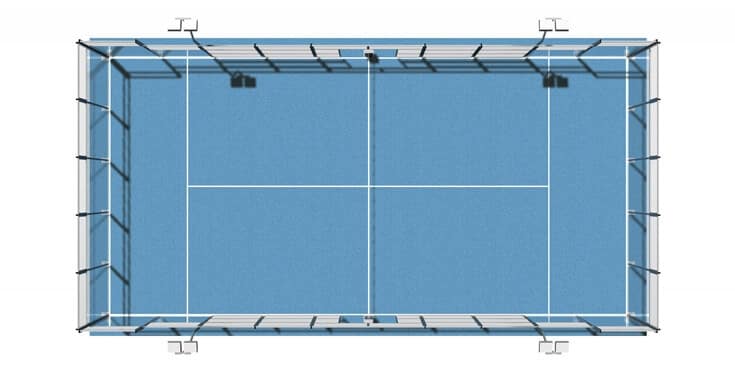
This is what the court looks like in padel
The court on which padel is played is very similar to a squash or tennis court. All these courts have playable walls and a net, and a padel court is usually rectangular in shape. The game is played on surfaces such as porous concrete, cement, or artificial grass.
The net on the court should be 10 meters wide and in the middle of the court, the net should be 0.88 meters high. Each end must be 0.92 meters high and the top of the net must have a white strip of 5 centimeters as a post.
At each pillar outside the playing field, the metal rope shall be attached and it is this rope on which the net is strung.
Lines
The lines should be positioned according to dimensional rules and should be in black or white. This is to ensure that the lines are clearly visible from the playing field. The width of the lines should be five centimeters and there should be a net in the middle of the pitch.
Walls
As mentioned above, the playing field is made up of a grid and walls, some of which are made of Plexiglas. The rear wall has a height of four meters, where three meters are made of glass and one meter is made of fence.
Size
The size of a padel court is 10×20 meters and the court is surrounded by walls. The walls are made of plexiglass and the rest of the sides are made of fence. Just like in tennis, a net separates the two halves of the court. The box in which you serve is five meters wide and about seven meters long.

Padel rules
In padel, there are always two players playing against two others. An approved racket is required, which must be attached with a strap at the wrist and also at the end of the racket. Which wrist, of course, depends on which hand you play with. A special ball for the game must be used in order to play correctly. Read all padel rules here.
You lose one point if this happens:
The ball accidentally bounces twice instead of once in your own half of the court.
The ball hits the wall first instead of the floor.
The ball hits the net before the floor.
The ball hits the net in your own half.
In the case of a double strike.
Two serve errors.
Sources:
The game it self
In padel, the ball may only be bounced once in your own half of the court and only touched by one player before it is allowed to pass to the opponents’ half of the court. The ball may be volleyed immediately after bouncing on the ground. It is also permitted to bounce the ball off the ground and into the wall before hitting it away, but the ball may only bounce off the ground once.
Serve
In padel, there are several different ways to hit a serve when play begins, whereas in tennis the game always begins with the same serve. In padel, the serve should always be hit from waist height or from below and you should stand behind the service line which is between the fence and the wall. The ball must always bounce once on the ground before it can be hit over.
The serve should be hit from corner to corner and across to the opponent’s side, where the ball should first bounce into the service box. The ball may then touch the plexiglass wall on the short or long side, and the opponent may in turn hit the ball back with or without contact with the wall, and of course, only bounce once on the ground.
If the ball hits the fence or the wall directly, it is a service fault, and the ball may not touch the fence after bouncing. In padel, there are also two ways to serve exactly as in tennis. If the ball touches the net and then the floor, the serve must be retaken. Read our best tips for hitting a great padel serve.
Scoring
In padel, the points are counted as in tennis, the first point (15), second (30), third (40) then fourth is game. If both teams have managed to score 40 points each, it is called (deuce – equal). The pair that wins the ball afterward has (advantage) and if they win again it’s game over and they receive the match point. Should the pair with the advantage lose the ball on the next stroke, it is deuce again. When one pair has won two balls in a row, it is game over.
Set
After the same pair has won six rounds, it counts as a set and the pair must then lead the game by two rounds at a minimum. Should the pair win five games each (draw), two more games must be played. If the score is 6-6 again, the tiebreaker is the deciding factor. When the tiebreak is played, the pair with the first seven points wins, but they must also win by at least two points.
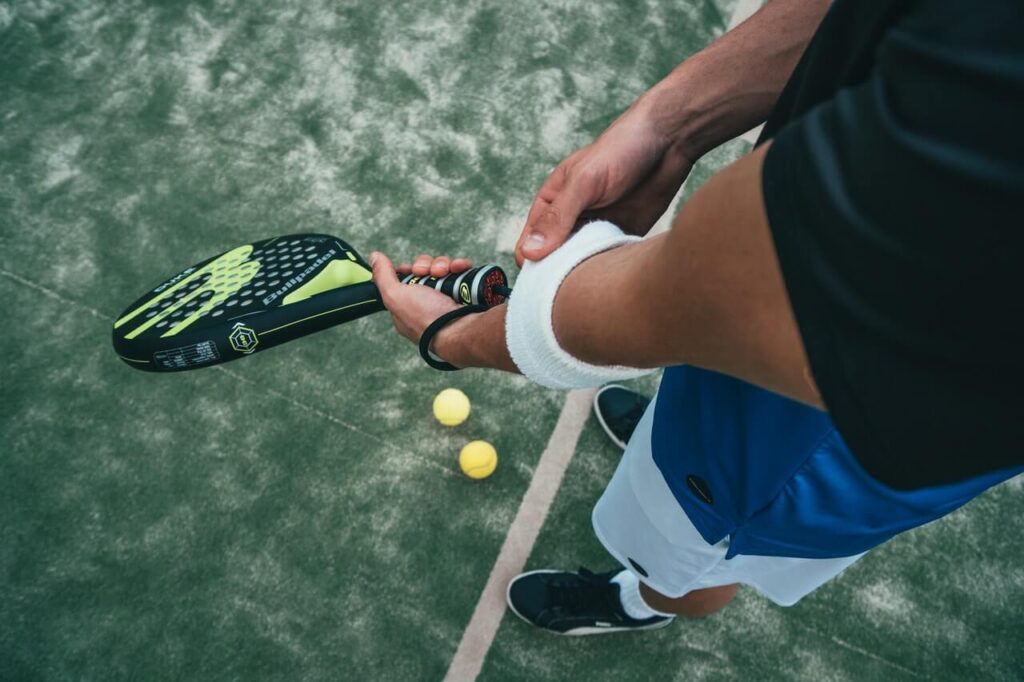
A brief history of padel and padel tennis
It is rumored that something similar to padel tennis was played on board British cruise ships as early as the 1920s. It is quite clear that Enrique Corcuera from Mexico is today mentioned as the man who invented the padle game that is reminiscent of today’s padel, which he started playing in the 1960s. The Spanish Prince Alfonso de Hohenlohe, who lived in Acapulco, Mexico, visited his good friend Enrique Corcuera in 1974. There, Alfonso was shown by Enrique how he had built a small tennis court on his property.
The facility had walls on all four sides. The ball was played against the walls just like in squash and the racket used was a perforated racket already used in padel tennis. The rules for the two ball sports and the court were changed slightly. As a result, Prince Hohenlohe took the game to heart and had two courts built on his private land.
It wasn’t long before padel became a domestic sport and more and more people, often from high social standing, took the game to other parts of Spain. Nowadays, padel is played almost all over the world, and federations and competitions have sprung up. The first world championship took place in Madrid in 1992, after the International Federation of Padel was founded in the same city. Nowadays,
Padel is Europe's fastest growing ball sport
In Europe, padel has quickly become a growing sport, even Sweden has discovered the sport. Clubs and members are growing fast and it’s clearly a trend that will continue. In 2020, the inaugural competition was moved from Båstad, which has previously had competitors from all over the world, to Malmö. Read about our compiled data and statistics for padel i Sweden.
From the 4th to the 8th of November 2020, the “Sweden Padel Open” had its competitions there. Worldwide, only eleven cities organize open padel competitions. In Sweden and the Nordic countries, Malmö had the honor of being the first major city to host a padel competition. Other countries include Madrid, Barcelona, and Buenos Aires. The first time the Swedish Padel Open was held in Båstad was in 2018 and the competition was followed up at the same venue in 2019 when around 16,000 visitors were there to watch the match.
With the move to Malmö, it brings thousands of visitors to a single event, while other international visitors will also want to check out Malmö, stay at their fine hotels, visit the sea, be able to visit Copenhagen, and eat the naturally produced food available there. 2.5 years ago there were only about 40 courts in Sweden, while by the end of 2018-2019 it had grown to over 1,000 courts and the development is constantly increasing. Padel, as I said, is inspired by both tennis and squash and it’s easy to learn how to play. It’s also fun because it’s fast-paced.
Those in charge of the Swedish Padel Open in Malmö believe that it can become a padel court where Sweden’s largest competitions will be held and that there can be close to 10,000 spectators per day.
Interest and practitioners have exploded in Sweden
In recent years, padel tennis has become extremely popular in Sweden. The Padel Federation has been formed, clubs are growing in number and membership is increasing all the time. Facebook has new pages and people are blogging about padel like never before.
It is certainly a sport that is here to stay in Sweden. When the Padel Federation applied in 2016 to join the National Sports Federation (RF), there were only two pages to fill in. The next time, the application consisted of 23 pages, and a lawyer from Lund was present throughout to make sure everything was done correctly.
At the time of writing, there are about 400 courts in Sweden and more are expected. Membership has exceeded 10,000 and around 1,000 players have a license. The sport first took off in Stockholm but has now spread across the country.
Over 500 padel facilities in Sweden
At the time of writing, there are about 500 courts in Sweden and more are expected. Membership has exceeded 10,000 and around 1,000 players have a license. The sport first took off in Stockholm but has now spread across the country.
One of Sweden’s biggest football stars, Zlatan Ibrahimovic, has taken the game to heart, buying and building several padel centers around Sweden. Through his involvement, many more Swedes are likely to take an interest in the sport.
Many celebrities' new favorite sport
Already in 2016, several famous Swedes competed in the very first version of the padel tournament, which was named DBP Open. Names like Måns Zelmerlöw, Tomas Brolin, Andreas Andersson, and Jesper Blomqvist were on the list of those who signed up to play.
This competition was divided into two different classes, an elite class where Olof Mellberg participated, who at that time was ranked as the 15th best player in Sweden. The second class had 32 participants and it was quite unexpected that so many players were drawn to the game.


